Physical Address
304 North Cardinal St.
Dorchester Center, MA 02124
Leukoplakia carries a small but significant risk of malignant transformation. The proliferative verrucous form has a far greater incidence of recurrence, multifocality, and absence of the usual risk factors and transformation rates of typical leukoplakia.
At the moment, no effective chemoprevention strategy for the management of leukoplakia has been proven, nor is there a predictable manner in which to judge its progression to carcinoma.
The risk of malignant transformation in cases of oral lichen planus and oral mucosal lichenoid lesions must be considered in the long-term aspect of patient follow-up.
The role of areca (betel) nut in the pathogenesis of oral submucous fibrosis in India and many other countries forms the basis for the high rate of oral squamous cell carcinoma reported in those locations.
Various forms of oral candidiasis will be encountered in practice, and the clinician must become familiar with various management options.
The specific antigenic target in pemphigus vulgaris is a member of the cadherin family of intercellular adhesion molecules.
Differences exist between pemphigus vulgaris and mucous membrane (mucosal) pemphigoid in terms of antigenic targeting and their anatomic localization.
Aphthous ulceration may present in three forms with a variable approach to management that ranges from observation only to the use of systemic agents.
Recurrent herpesvirus activation may form the basis for the development of recurrent erythema multiforme; thus the use of prophylactic viral suppression treatment should be considered.
The differential diagnosis of oral mucosal pigmentation includes a number of entities that range from innocuous to life threatening. Thus the index of suspicion for such lesions is an important clinical consideration.
Red and white lesions represent a unique category of lesions that comprises a variety of entities.
Leukoedema presents as a diffuse and generalized mild, surface milky opacification that chiefly involves the buccal mucosa. It essentially represents a normal variation of surface mucosal texture and characteristics and can be identified in large numbers within the population, in particular in tobacco users, and it is most marked in those who possess higher levels of cutaneous and mucosal pigmentation; it is present in the majority of black adults and in nearly half of black children, and it has also been noted as a Cannabis -related side effect.
No clear cause of leukoedema has been established. Factors that may have a role in its manifestation include smoking, Cannabis use, alcohol ingestion, bacterial infections, electrochemical interactions, and possibly inflammatory salivary disorders; however, no specific, reproducible, or definitive cause has been proven to date. Many authorities indicate that this hardly represents a disease entity but rather may be considered a variation of what is normal. Similar edematous alterations of mucosa may also be seen in the vagina and larynx, which further supports the notion that leukoedema is indeed a normal variant of mucosal surface appearance. The incidence of leukoedema increases with age up to 40 to 49 years, followed by a decline.
Leukoedema is asymptomatic in nature and is usually discovered incidentally during routine examination or by the patient. The distribution tends to be symmetric and involves the buccal mucosa and, to a lesser extent, the labial mucosa. The appearance may be that of a diffuse, filmy grayish surface with white streaks, wrinkles, folds, or milky alteration ( Fig. 87.1 ). At rest, the tissue may appear opaque, whereas when stretched, the mild opaque alteration dissipates to the point that it is barely visible.
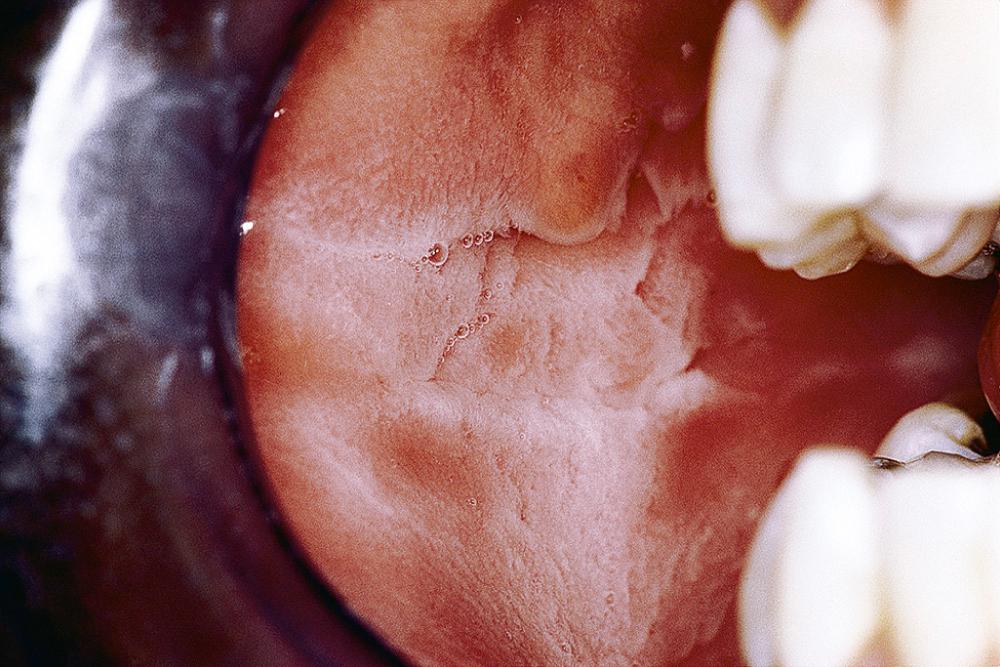
Simply stretching the mucosa will cause the altered area to essentially disappear; however, leukoplakia or hyperkeratotic conditions will not demonstrate similar attenuation, which thus allows separation of this condition from leukoplakia. Other conditions that should be clinically separated from leukoedema include white sponge nevus, reactive keratosis caused by chronic low-grade trauma, the homogeneous form of lichen planus, and hereditary benign intraepithelial dyskeratosis.
The surface of the epithelium is usually parakeratinized, whereas the epithelial ridges are broad and elongated with occasional spike-type morphology. Dominating the histomorphology is marked intracellular edema within the prickle cell or spinous cell layer, where individual cells will appear enlarged and optically clear or vacuolated, with peripherally displaced pyknotic nuclei and an overall bland appearance in association with a volumetric increase in the thickness of the epithelial layer ( Fig. 87.2 ).
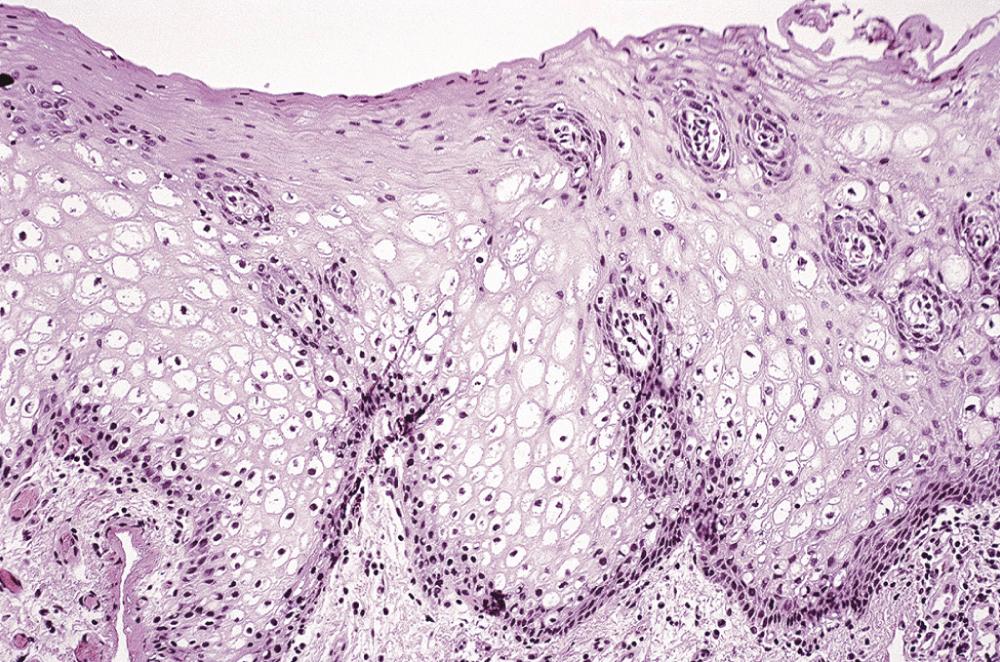
This particular mucosal alteration does not require treatment, because it is totally benign. There have been no reported cases of dysplastic alteration or transformation to carcinoma. The major concern relative to leukoedema is separating it from leukoplakia.
Oral leukoplakia can be defined as a white patch or plaque that cannot be otherwise characterized clinically as representing any other disease entity. This removes de facto the concept of leukoplakia from the histopathology laboratory to the clinician in terms of definition and utility. From a historic, albeit erroneous perspective, many pathologists and clinicians use the term leukoplakia synonymously with microscopic alteration , in particular that of degrees of epithelial dysplasia or in situ carcinoma. The exclusionary diagnosis of leukoplakia will therefore eliminate more easily recognizable conditions that include leukoedema, lichen planus, candidiasis, and white sponge nevus.
It is agreed that leukoplakia represents the most common premalignant oral mucosal lesion; however, most cases are benign and remain so over time. The concept of malignant transformation is essentially related to the development of cancer, preinvasive or otherwise, that is further characterized by variable degrees of epithelial dysplasia. The possibility of carcinoma and dysplasia must be carefully considered; microscopic evidence of dysplasia is seen in 3.7% to 28.7% of cases of leukoplakia. A more recent review pointed out that the malignant transformation potential of leukoplakia was noted by Sir James Paget in 1851, when he provided the essential description of what we currently consider to be representative of leukoplakia. The entity of oral leukoplakia was initially and specifically described in the latter half of the 19th century by the Hungarian dermatologist Schwimmer. Since the late 18th century and into the 19th century, oral leukoplakia has been recognized and fully established as a definitive precancerous lesion, although in the minority of cases, it serves as a harbinger for the development of oral cancer. The major clinical factor of importance in this lesion lies in its relationship to the general morbidity and relatively high overall mortality associated with invasive squamous cell carcinoma (SCC).
Conceptually, therefore, the definition of a premalignant lesion may be that of a morphologically altered tissue, within which cancer is more likely to develop when compared with its apparently normal counterpart. In a more contemporary sense, the work of Waldron and Shafer (1975) and Bouquot and Gorlin (1986) established the clinical and microscopic correlation of leukoplakia in a large number of people within the United States. In those studies, the presence of dysplasia, carcinoma in situ, and invasive carcinoma in relation to oral leukoplakia from all sites ranged from 17% to 25%.
A wide range of prevalence is noted worldwide, with relative prevalence rates in the United States of approximately 1% to 2%, whereas in India, people over 15 years of age demonstrated leukoplakia in up to 4.9% of those examined. Leukoplakia is most commonly seen in middle-aged and older men, and it is uncommon in men under 30 years of age; prevalence rises to nearly 30% in men over 80 years of age, and rates are significantly higher where the use of betel (areca nut extract) is common.
Although the cause of oral leukoplakia is unknown, several habits and behaviors are associated with the presence of this clinical lesion. Most closely associated with leukoplakia is the use of tobacco in its many forms, including smoked tobacco and several forms of smokeless tobacco. In other cultures, the use of areca (betel) nut preparations with or without tobacco forms an additional impetus for the development of this condition in patients.
By far, the most common cause of oral white lesions is trauma, which includes friction-related keratosis; however, this is not a true leukoplakia in that it represents a response to trauma in the form of hyperkeratosis with reversal of such on elimination of the traumatic influence. A common site for frictionally induced hyperkeratosis is along the buccal mucosa at the occlusal line. At this location, the formation of a linea alba is noted, whereas over the labial mucosa, a lip-biting habit can produce a slightly granular hyperkeratotic surface alteration or so-called morsicatio. No evidence suggests that chronic frictional trauma transforms into dysplastic or frankly malignant disease.
Along the lower lip vermilion surface, patches of leukoplakia may develop in response to chronic sun exposure (actinic cheilitis), which demonstrates close correlation with cumulative exposure and the level of cutaneous pigmentation ( Fig. 87.3 ). An additional form of keratosis has been attributed to the use of mouthwash preparations and toothpaste that contain an herbal root extract called Sanguinaria (Viadent). Characteristically, the lesion develops along the labial alveolar mucosa of the maxilla as an often translucent to slightly opaque white patch with well-defined margins and generally smooth surface features ( Fig. 87.4 ). The relationship to development of dysplasia or malignant transformation in association with this entity remains controversial, and reversal of lesions is often noted upon withdrawal of Sanguinaria -containing products.
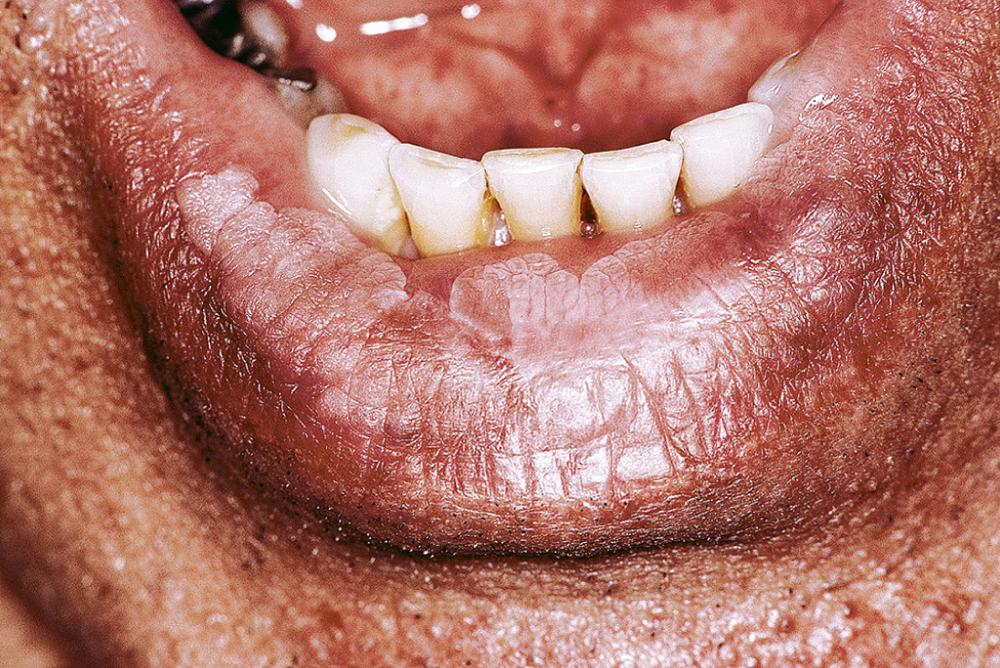
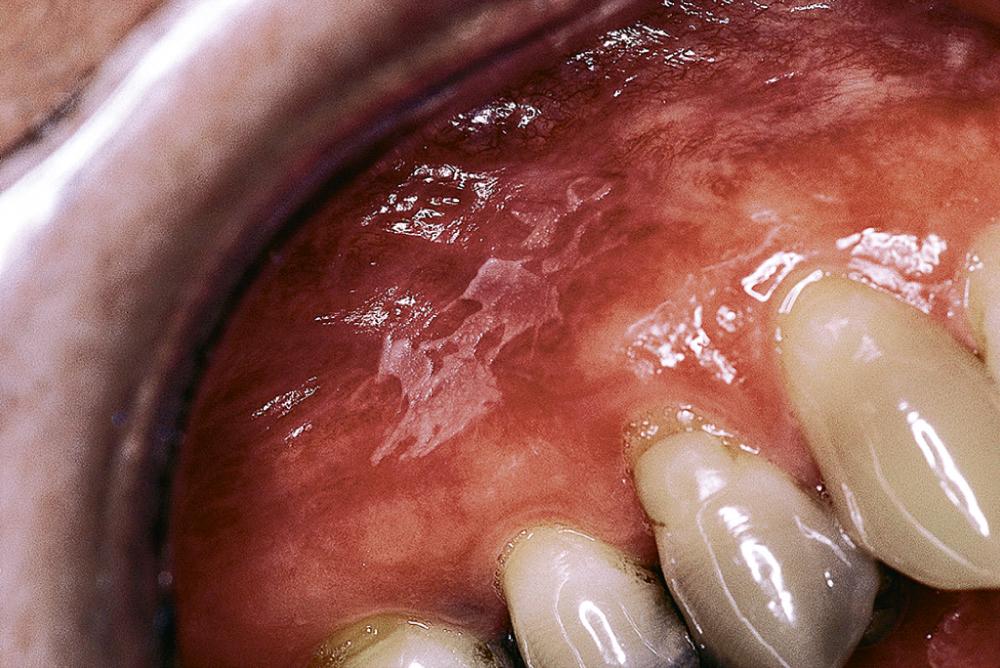
A widely variable clinical pattern characterizes leukoplakia. In general, the appearance can range from a thin, grayish surface alteration that demonstrates a white translucent quality with ill-defined margins ( Fig. 87.5A ) and generally smooth surface qualities to discrete, sharply marginated, thick and opaque plaques. In general terms, such lesions may be homogeneous and smooth, focal or diffuse, or heterogeneous and multifocal with variable textures (see Fig. 87.5B and C ). Surface textural alterations can range from a fine granularity to a slightly papillary outline. In addition, leukoplakia can appear ulcerative, erosive, speckled, nodular, or verrucous to the naked eye. Importantly, the various forms of leukoplakia often transition from one to another; however, this change of clinical appearance may not necessarily correspond to a shift in biologic behavior. When a clinical shift in appearance occurs from homogeneous leukoplakia to a heterogeneous, speckled, or nodular form, a rebiopsy is mandatory (see Fig. 87.5D ) because of the well-established correlation between increasing levels and frequencies of dysplasia and an increase in the level of regional heterogeneity, or a speckled quality.
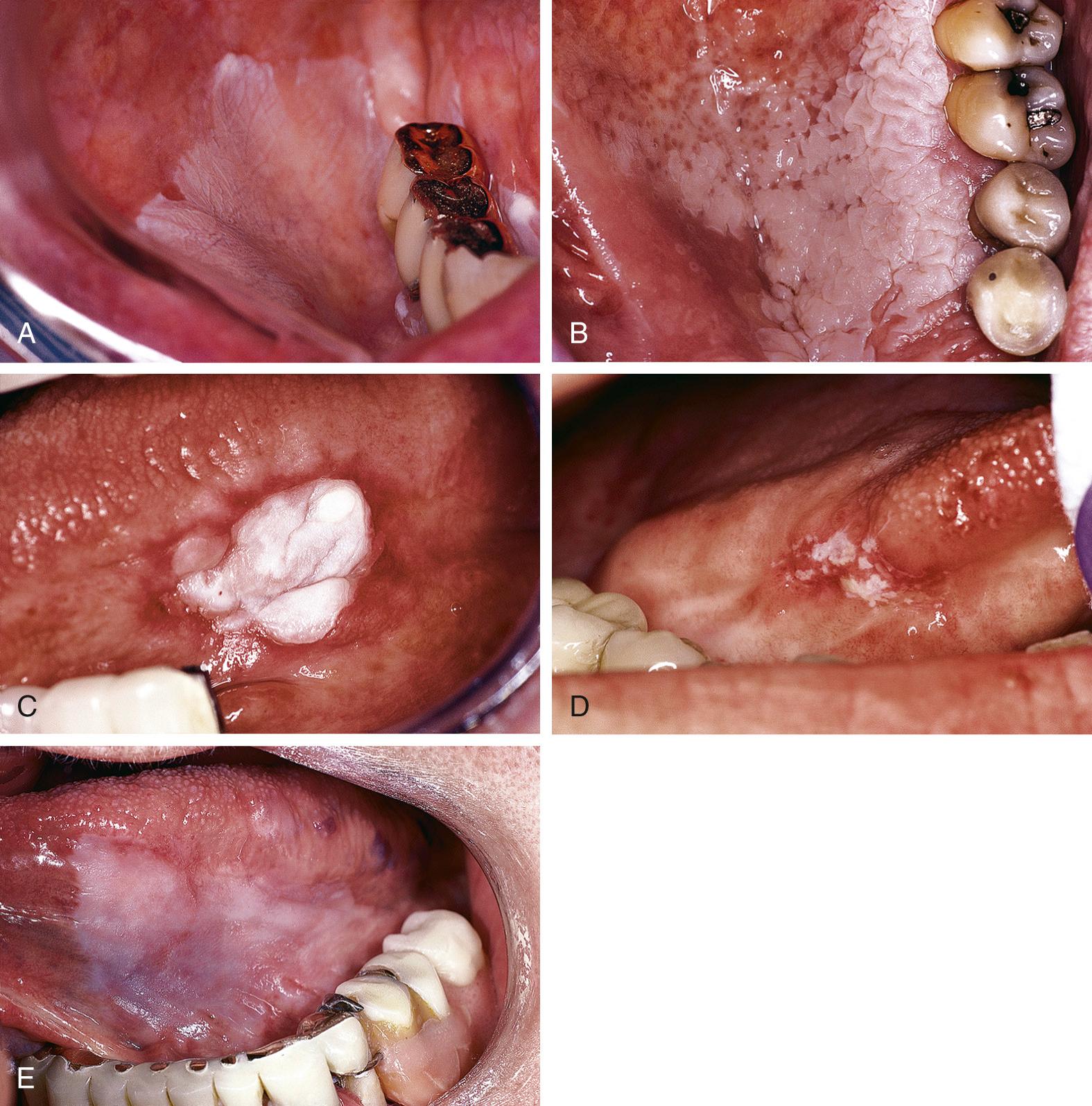
The term thin leukoplakia (see Fig. 87.5E ) has been used to describe early leukoplakia formation. Such lesions generally progress over time from a macular to a slightly elevated translucent plaque with blending margins into normal-appearing mucosa to later development of a more thickened appearance, which lends a more opaque white color to the lesion. Likewise, textural features may develop with increasing duration, which may be furrowed, leathery, or wrinkled in appearance. Similarly, lesions can become exophytic or verruciform in quality and might project above the surface. Although many lesions may remain for extended periods as homogeneous or more textured, thickened alterations, some lesions may disappear over time.
An uncommon variant of leukoplakia, proliferative verrucous leukoplakia , requires a separate designation in that it is often noted in individuals without the usual risk factors for leukoplakia development, with lesion development noted in areas less commonly affected by oral SCC. Behavior of this variant of leukoplakia is characteristically aggressive with changing histopathologic features, a more relentless behavior pattern, and greater tendency to develop into SCC. No linkage to human papillomavirus (HPV) has been demonstrated in comparison with other forms of oral leukoplakia. It is characteristically multifocal and persistent and tends to occur more often in women. An evolution from a thin, flat, white patch to a leathery, thickened, and ultimately papillary to verrucous stage characterizes this lesion over time ( Fig. 87.6 ). When the lesion is microscopically evaluated at the papillary or verrucous stage, the diagnosis can vary from that of a benign or atypical verrucous hyperplasia to verrucous carcinoma or SCC with papillary features. Likewise, what characterizes this entity is persistence, a high recurrence rate, and development of SCC in up to 74% of cases. Gaining a better understanding of the behavioral qualities and variation across the spectrum of oral leukoplakia involves several factors that include clinical appearance, location, and the presence and degree of dysplasia. Recent studies have demonstrated an association between progression of oral mucosal premalignancy and a loss of heterozygosity. An essential step in the initiation of escape from normal epithelial proliferation and differentiation involves loss of heterozygosity at 3p and 9p, where a modest 3.8-fold relative risk for oral cancer development has been noted. However, in cases where additional losses (4p, 8p, 11q, or 17p) existed, a 33-fold increase in relative risk for cancer development was noted. Lending a risk-targeting or prognostic strategy to this concept has been controversial, with earlier work concerning ploidy analysis being discredited and more recent studies refuting this claim. No single or specific molecular pathway has been identified as the primary factor in the progression of epithelial dysplasia to SCC. Continuing studies have revealed a range of molecular and genetic changes associated with oral SCC tumorigenesis that include mitochondrial alteration and several epigenetic changes, with continued ongoing investigation of altered methylation patterns and early carcinogenesis. Finally, the relationship between the site of leukoplakia and the presence and risk of dysplasia or carcinoma must be considered. Earlier and more recent studies have underscored this relationship, and the floor of the mouth, ventrolateral tongue, and retromolar trigone/soft palate complex carry risk levels greater than other oral sites.
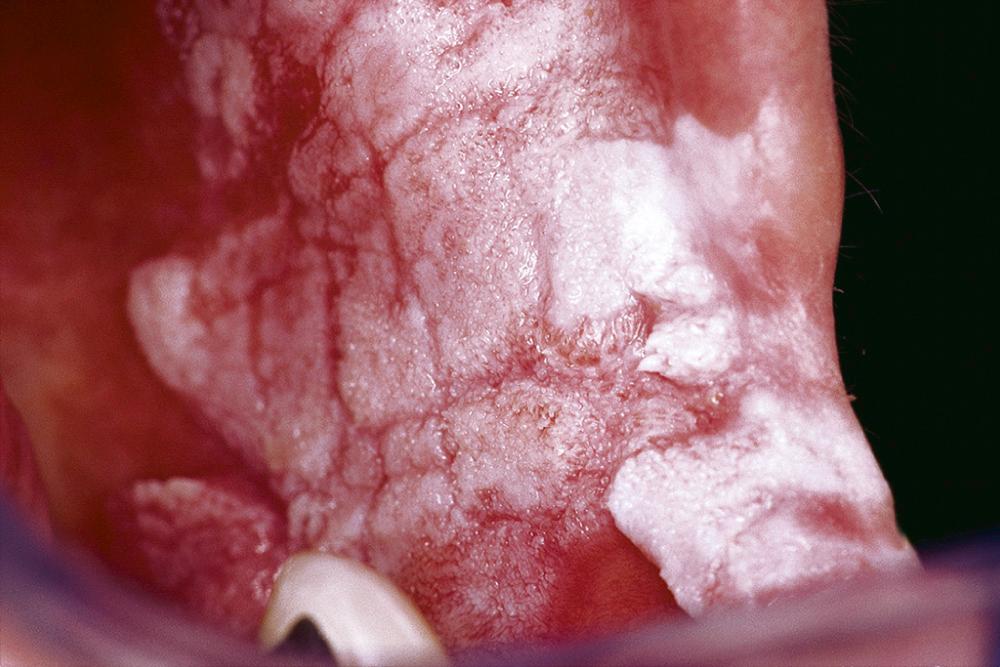
A spectrum of histologic alterations characterizes idiopathic or true leukoplakia and ranges from hyperkeratosis and acanthosis to variable degrees of dysplasia or carcinoma in situ and ultimately to invasive SCC ( Fig. 87.7 ). Cellular atypia , a component of dysplasia, refers to abnormal cellular features, whereas dysplasia refers to disordered cell growth and architectural distortion. With dysplasia, a grading system of mild, moderate, or severe is the convention; the level is determined subjectively in an attempt to convey tissue alteration to the level of intraepithelial localization or a nonneoplastic or noninvasive quality.
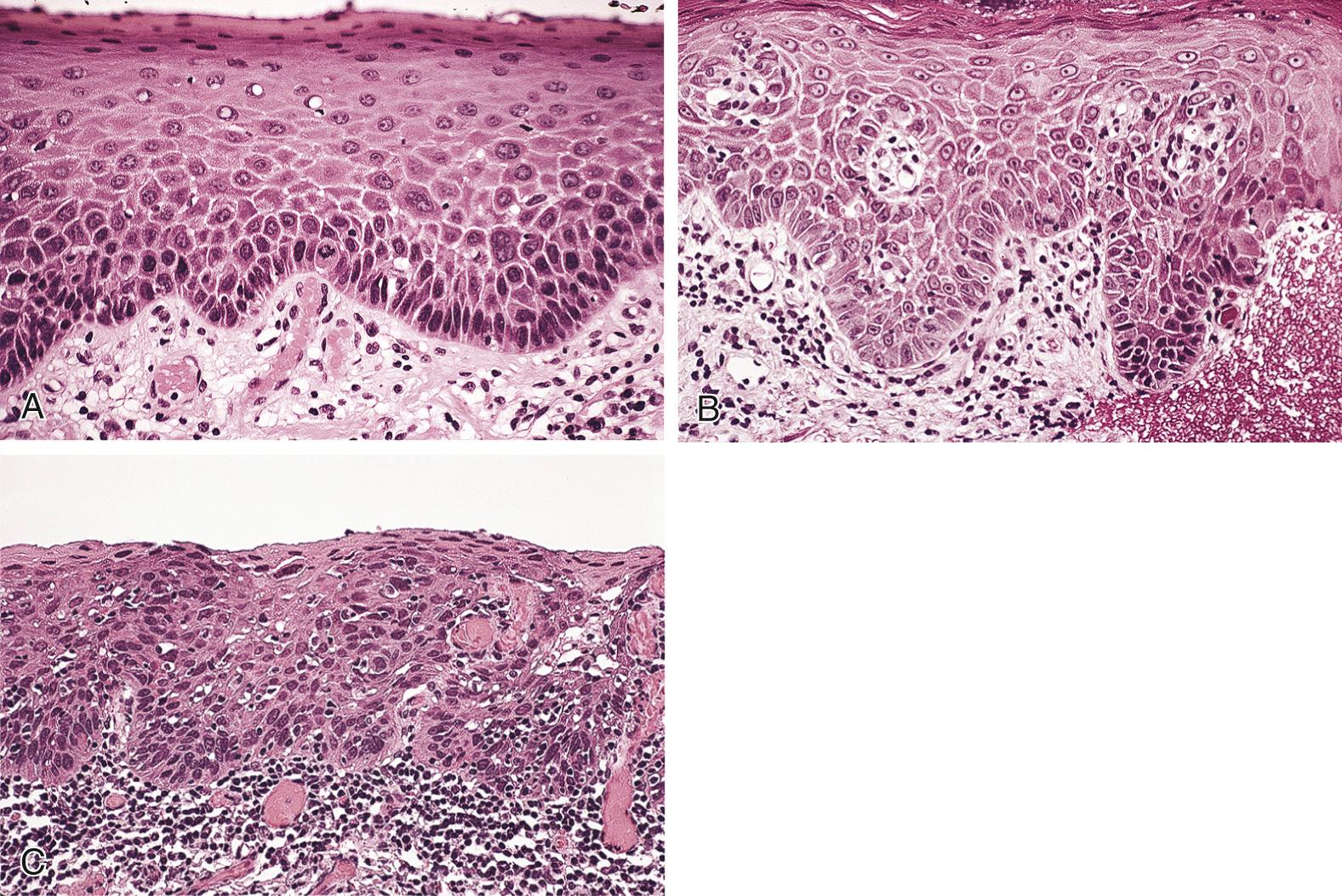
Specific microscopic features of dysplasia include drop-shaped epithelial ridges, basal cell hyperplasia, irregular stratification and cellular maturation sequence, increased levels and abnormal quality of mitotic activity, individual cell or group level keratinization between the suprabasal and surface layers, cellular pleomorphism, altered nuclear/cytoplasmic ratio, reduced intercellular adhesion, and loss of basal layer polarity with “streaming” of spinous layer cells toward the surface.
An extension of these microscopic alterations to involve the entire epithelial compartment (i.e., a “top-to-bottom effect”) allows use of the carcinoma in situ designation. Alternatively, the term can also be used to designate particularly severe epithelial dysplasia that may not be fully developed from the basal layer through the surface layers.
Management of idiopathic leukoplakia will depend on the nature of the associated histologic findings obtained by incisional biopsy, because the clinically defined term leukoplakia requires microscopic characterization. With extensive lesions, multiple biopsies may be required to preclude errors of sampling, with the most clinically suspicious areas—such as erythematous, granular, ulcerated, and indurated areas—included.
Once a lesion has been defined as benign, premalignant, or malignant, a treatment plan can be formulated. In the case of benign or minimally dysplastic lesions, periodic simple observation or excision is an elective option, whereas premalignant lesions of moderate dysplasia or worse demand removal. The issue of how to manage mildly dysplastic lesions may concern itself with careful follow-up and observation or removal, if clinician and patient are committed to such. Complete removal of these lesions can be accomplished by a wide array of modalities that include scalpel excision, laser ablation, electrocautery, or cryoablation.
The role of chemoprevention strategies in cases of mild dysplasia or treated dysplasia remains an active and important area of research, although no proven and effective prevention strategy has been established in regard to malignant transformation. Retinoids, antioxidants, and cyclooxygenase 2 inhibitors hold promise as management alternatives within the area of chemoprevention, although no effective strategy has yet been proven by randomized clinical trials. In general, no effective treatment is available to prevent malignant transformation of leukoplakia. On balance, and regardless of location, the dynamic nature of oral leukoplakia and its cancer-related potential should be appreciated and understood. The key to limiting the likelihood of late-stage disease evolving from such lesions concerns itself with an appreciation of the potential of this group of mucosal alterations coupled with the establishment of early diagnosis, intervention, and follow-up.
On balance, it may be said that a benign behavior pattern is characteristic of a vast percentage of oral leukoplakia cases, with an absence of accepted biologic factors that accurately predict transformation into malignancy.
A distinctive asymptomatic white lesion of the oral mucosa, oral hairy leukoplakia has been defined both clinically and microscopically with a distinct relationship in the vast majority of cases with systemic immunosuppression. It must be noted, however, that this condition may be observed in HIV-negative individuals, including those immunosuppressed for a variety of reasons that include hematologic malignancies and stem cell or solid organ transplantation. The Epstein-Barr virus (EBV) is considered to be the etiologic agent of this lesion that characteristically arises along the lateral tongue margins bilaterally, ranging from subtle white keratotic vertical streaks to thick corrugated and then to shaggy surface alterations ( Fig. 87.8 ). Early lesions may be more smoothly textured and macular in presentation. Less common sites include the dorsum of the tongue, buccal mucosa, and floor of the mouth.
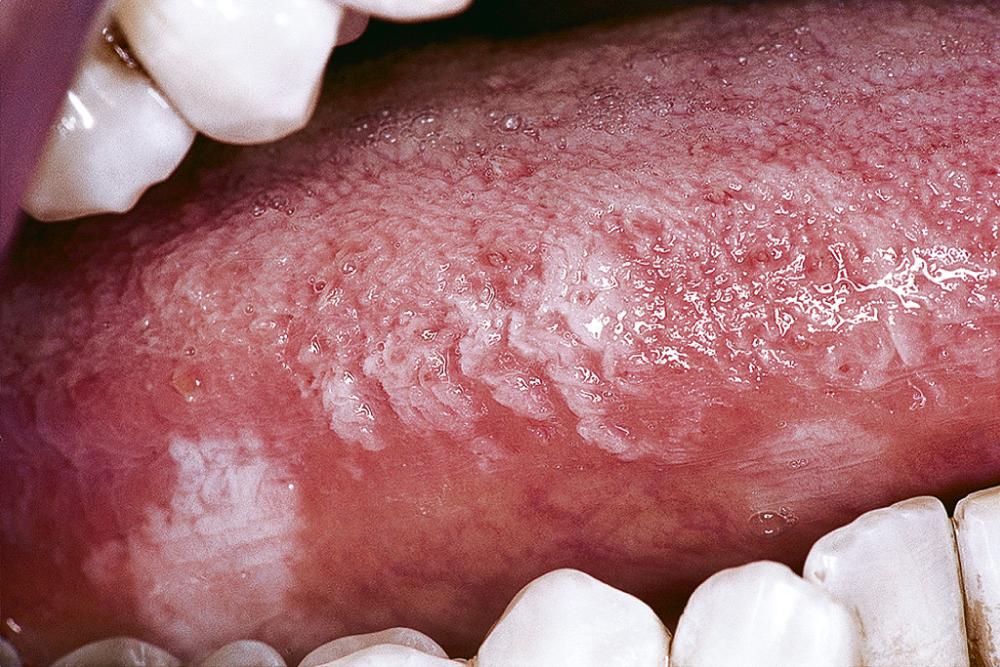
Diagnosis by routine microscopy and in situ hybridization to demonstrate the presence of EBV is essential in that the confirmed diagnosis almost always correlates with systemic immunosuppression. The microscopic features suggestive of this diagnosis include hyperkeratosis and irregular surface projections and irregularities ( Fig. 87.9 ). Ballooning degeneration of the subsurface layers with nuclear alterations that consist of clearing and chromatin displacement by viral replication occurs along the inner aspect of the nuclear membrane in the form of “beading.” Confirmation of the impression of a viral process can be achieved by in situ hybridization, Southern blot procedure, polymerase chain reaction, or ultrastructural demonstration of virus.
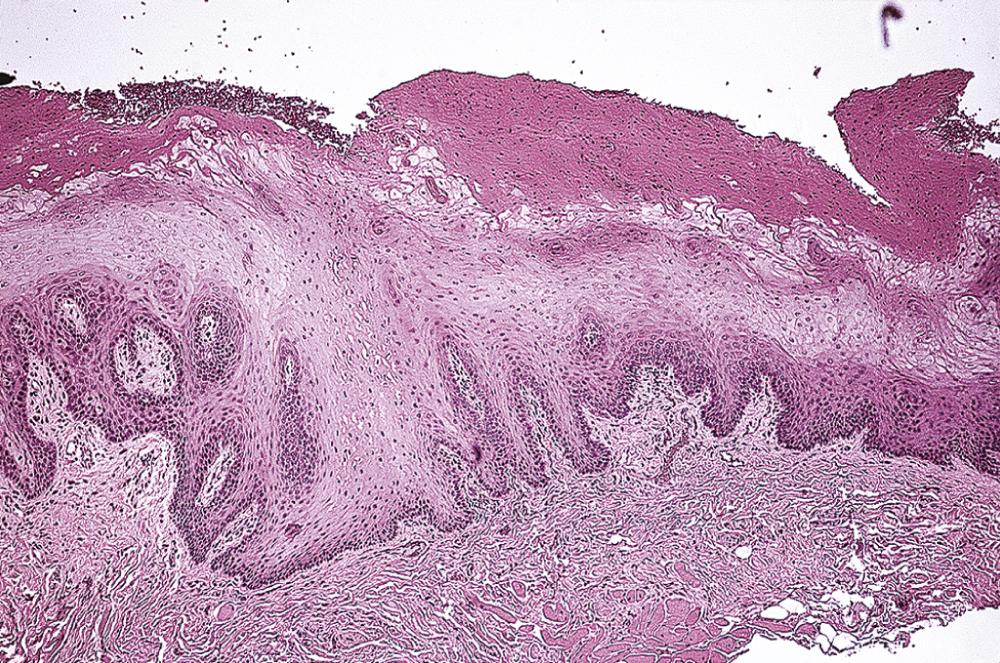
Management of hairy leukoplakia is not necessary in that establishment of the diagnosis remains the crucial task. In patients with proven association of HIV/AIDS, disappearance of the lesion usually accompanies antiretroviral therapy.
Oral lichen planus is a relatively common mucocutaneous disease of immunologic origin. It is mediated by a T-cell lymphocytic reaction to antigenic components within the surface epithelial layer or by exogenous antigens that trigger the development of an aberrant immune response. The overall frequency of this condition is between 0.2% and 3% of the population. Characteristically, over the oral mucosa, lichen planus typically presents as white striaform lesions that are bilaterally symmetric in their distribution, which, in this particular state, are relatively asymptomatic. However, other variants, in particular the erosive and ulcerative forms, will often be quite painful and may be what directs patients to seek care. The clinician should be concerned with the frequency of this disorder as well as the overall differential diagnosis, its similarity to other mucosal disorders, and its not infrequent symptomatic behavior.
Although the general etiology of lichen planus is unknown, it is generally thought to represent a T-cell–mediated or immunologically driven chronic inflammatory process in the absence of any consistent serologic changes. Immunologic studies have demonstrated that the lymphocyte subpopulations involve cells of mixed CD4 + and CD8 + types that express α-1 integrin molecules. The majority of the T cells present are activated CD8 + cells. Existing data suggest that a complex nonspecific mechanism might be involved in pathogenesis, including major histocompatibility complex class 1- and class 2-restricted antigen presentation by lesional keratinocytes, activation of antigen-specific CD4 + helper T cells and CD8 + cytotoxic T cells, clonal expansion of antigen-specific T cells, and keratinocyte apoptosis triggered by antigen-specific CD8 + cytotoxic T cells. More recent studies, however, have discussed the monoclonal nature of lesional T cells in oral lichen planus. Antigen-specific mechanisms therefore include antigen processing by resident dendritic cells and antigen-specific keratinocyte killing by CD8 + cytotoxic T cells. A host of nonspecific mechanisms also seems to be involved in pathogenesis, including activation of matrix metalloproteinases, mast cell degranulation, alterations in the epithelial basement membrane region, and elaboration of an array of proinflammatory cytokines, including RANTES (regulated on activation, normal T-cell expressed and secreted); these play a vital role in inflammatory cell recruitment into the area of the affected skin or mucosa.
An additional important factor in pathogenesis concerns basal and parabasal layer keratinocytes that express MHC class 2 molecules, which they present to cells bearing CD4 + -associated T-cell receptors. The basement membrane alterations described above result in the deposition of large amounts of fibrinogen in this region, which proves valuable within the context of the direct immunofluorescence testing and helps to establish a diagnosis. In the process of basement membrane damage, upregulation of additional molecules occurs and includes laminin, fibronectin, and types 4 and 7 collagen.
As a result of lymphocyte adhesion along the inner aspect of the superficial vessels within the lamina propria of the mucosa, they soon exit the vasculature to traverse the basement membrane and migrate into the overlying epithelium secondary to the upregulation of chemoattractants by keratinocytes.
Oral mucosal lesions of reticular lichen planus are most commonly seen in the middle-aged population with a characteristic distribution over the buccal mucosa in a symmetric bilateral manner. Women are affected more frequently than men, in up to 75% of cases in some series. The surface of the mucosa is characterized by delicate white keratotic striae that intersect and arborize over a mucosal surface that may be diffusely erythematous to normal in quality ( Fig. 87.10 ). Striae may be preceded by keratotic papules, which fuse and ultimately form the striae. The pattern is generally lacy to annular in configuration with extension over the buccal mucosa and often inferiorly into the mucobuccal folds. Striae may also appear over the dorsum and lateral portion of the tongue and less frequently over the attached gingiva and vermilion portion of the lip. Of note is the general freedom from symptoms related to this form of oral lichen planus.
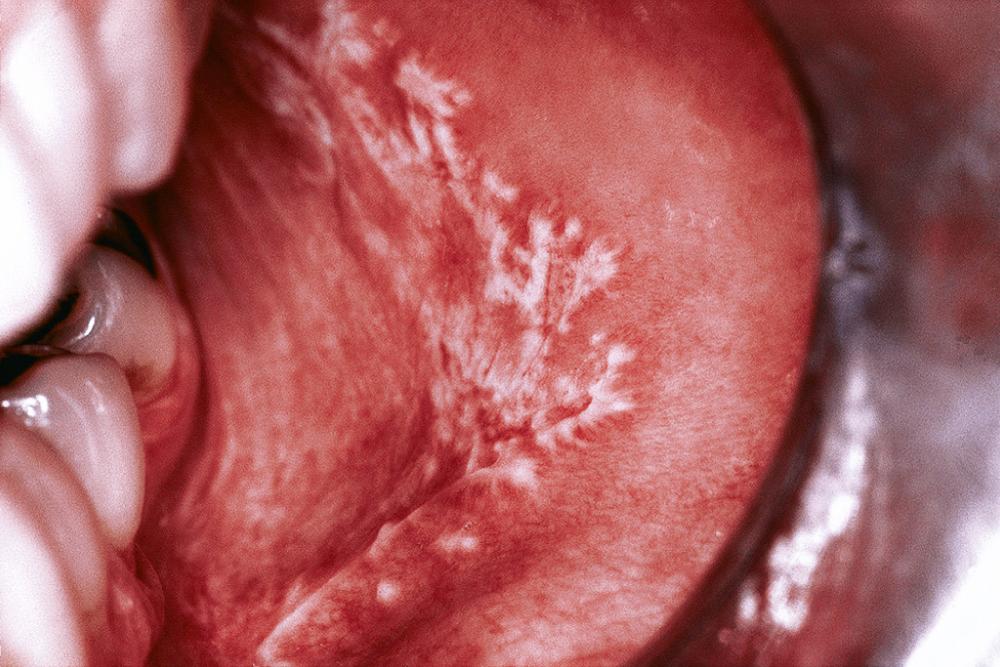
Other forms of oral lichen planus include the plaque form, the atrophic or erythematous form, and the erosive form. Characterizing the erosive form is a typically multifocal pattern of distribution, usually over the lateral and ventral tongue and buccal mucosa, whereas the plaque form can be smooth and macular to slightly elevated and minimally fissured. Although this form may be noted as the only presentation of oral lichen planus, it can also develop in late stages or in previous areas of erosive lichen planus that had been successfully treated.
The atrophic or erythematous form of lichen planus demonstrates only faint white striae and is dominated by thinned, reddened mucosa often noted concomitantly with reticular or erosive forms of this disease. The attached gingiva is most likely to be involved by this type of lichen planus where there is a loss of the usual pink, stippled quality of the tissue surface ( Fig. 87.11 ). In its place is a glossy, edematous, and erythematous alteration that is tender and bleeds easily, which leads indirectly to the accumulation of large amounts of dental bacterial plaque. This usually results from the inability of patients to maintain their usual levels of dental hygiene given the friability and tenderness of the gingiva, which bleeds with the slightest provocation. Bacterial antigens and toxins in turn elicit the formation of inflammatory cytokines locally that further enhance the immunologically driven process within the lichen planus. Erosive lichen planus is characterized by central, painful ulceration that is usually superficial in nature but can be deep and tender ( Fig. 87.12 ). The ulcer is surfaced by a pseudomembrane or firmly adherent fibrinous plaque, which is usually sharply demarcated. Often it is possible to identify peripherally localized white striae, which gradually transition to an erythematous, nonstriaform region as the ulcerated area is approached. As the erosions heal, new areas will break down into ulcerations with variable patterns of change noted over time.
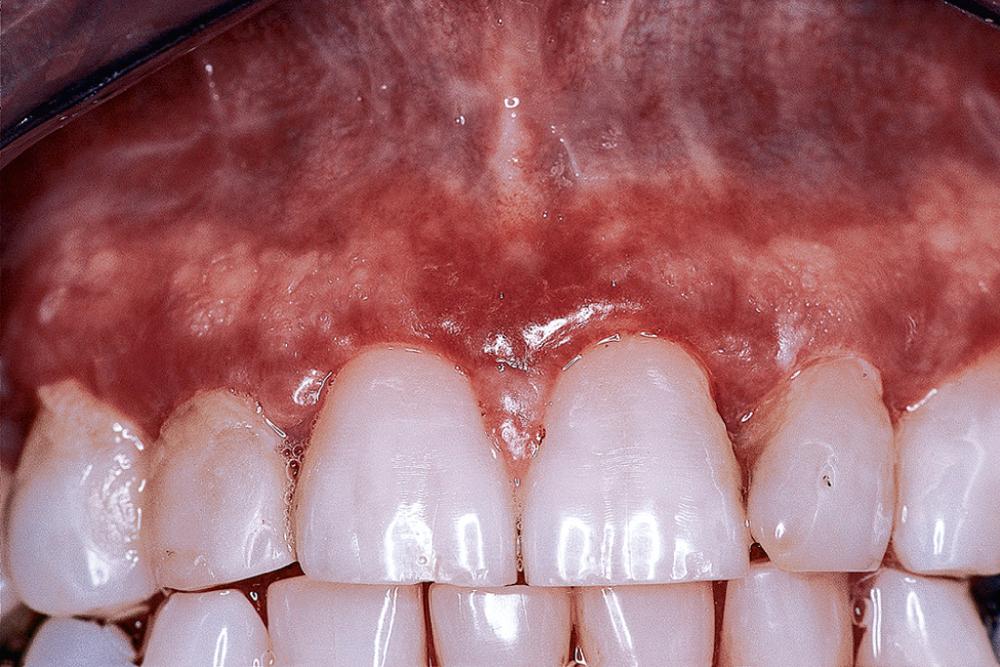
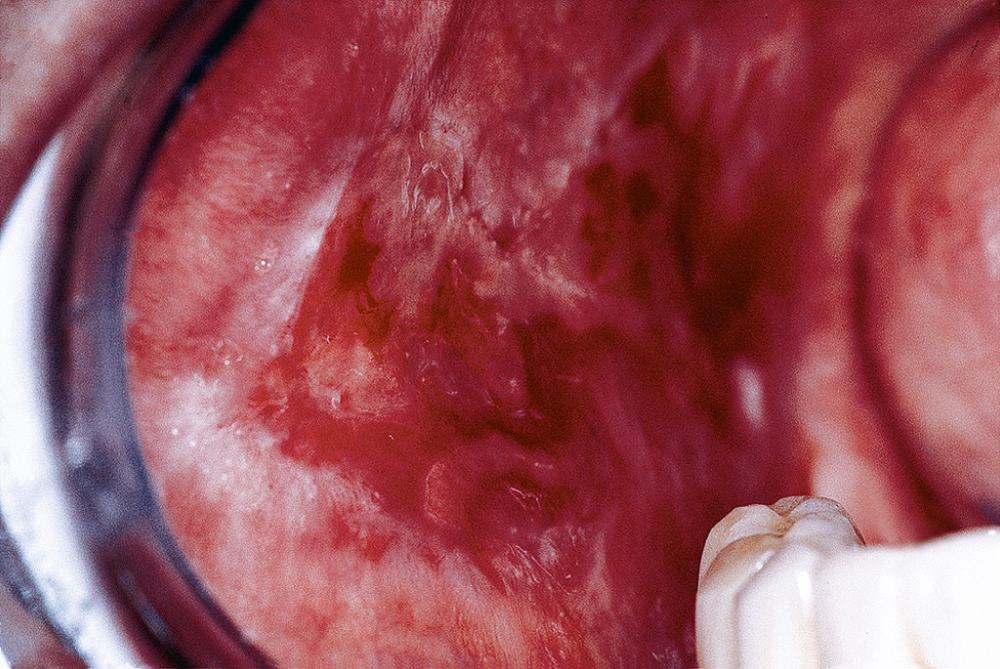
Rarely encountered is the bullous variant of oral lichen planus, with bullae that range in size from a few millimeters to greater than 1 cm. As with most oral bullae, they are transient, and on rupturing, painful ulceration results, with most lesions noted over the inferior and posterior aspects of the buccal mucosa. More typical forms of oral lichen planus are likely to be present elsewhere in the mouth in association with this variant, which makes the clinical diagnosis less difficult.
The multifocal, bilateral nature of oral lichen planus will usually help exclude certain mucosal abnormalities such as traumatic keratosis and leukoplakia. Included, however, are lupus erythematosus, lichenoid drug reactions, graft-versus-host disease, candidiasis, and oral hairy leukoplakia. Plaque-type lesions can be confused with SCC and leukoplakia; however, bilaterality and additional lichenoid alterations elsewhere will usually help separate these entities. With erosive/atrophic lichen planus that involves the gingiva, consideration must be given to MMP, pemphigus vulgaris, contact hypersensitivity, chronic atrophic candidiasis, lupus erythematosus, and erythema multiforme (EM).
Oral lichen planus has been reported in conjunction with primary sclerosing cholangitis, lupus erythematosus, primary biliary cirrhosis, and Sjögren syndrome. A somewhat controversial theory suggests that oral lichen planus may have a genetic susceptibility or predisposition. The theory is based on the finding that the association of oral lichen planus with other systemic diseases, especially hepatitis B and C, is less common in certain areas of the United States than it is in Italy and Japan.
At the free surface of the epithelium, hyperkeratosis and/or parahyperkeratosis will be present. A slightly thinned to atrophic spinous layer overlies the basal and parabasal layers, which are often degenerate and vacuolated ( Fig. 87.13 ). Over time, the epithelium becomes thin and may assume a sawtooth pattern on occasion. Scattered throughout the epithelium are increased numbers of dendritic cells that have been reported to function as antigen-processing units that deliver prepared antigen to the subjacent lymphocyte population, which morphologically forms a dense, band-like pattern at the epithelial–connective tissue junction. At this junctional zone, occasional ovoid, anucleate eosinophilic droplets with hyaline features are noted that represent apoptotic keratinocytes termed colloid or Civatte bodies . Although nonspecific and nondiagnostic of lichen planus, Civatte bodies are highly suggestive of this disorder when correlating other pathologic and clinical findings. Evidence of the altered basement membrane region is the nonspecific deposition of fibrin that can be demonstrated by direct immunofluorescence studies as a uniform linear deposition along the basement membrane ( Fig. 87.14 ). This pattern can be noted in up to 90% to 100% of cases.
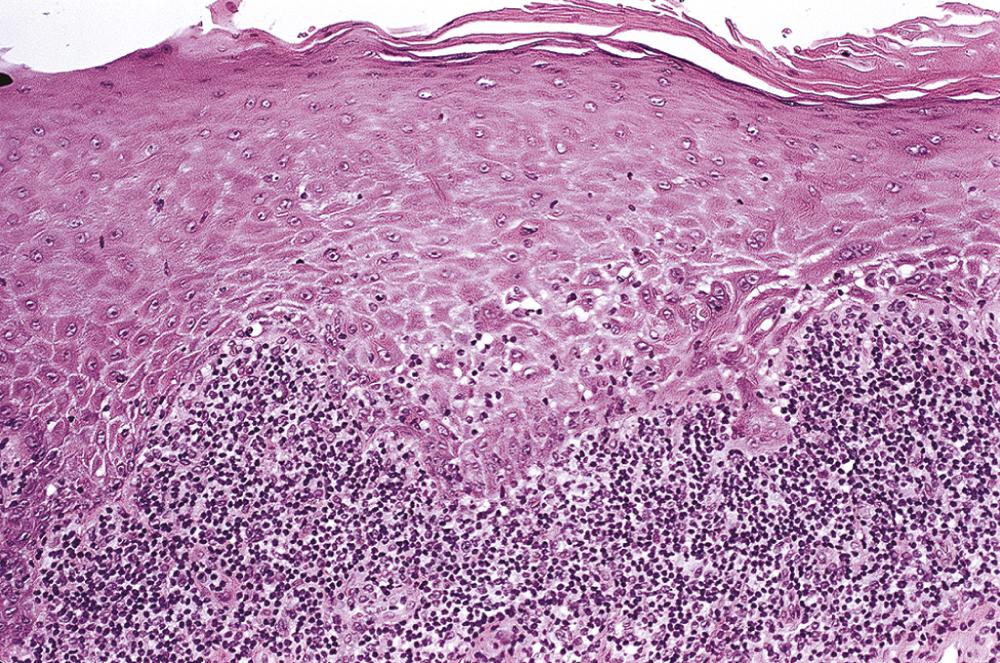
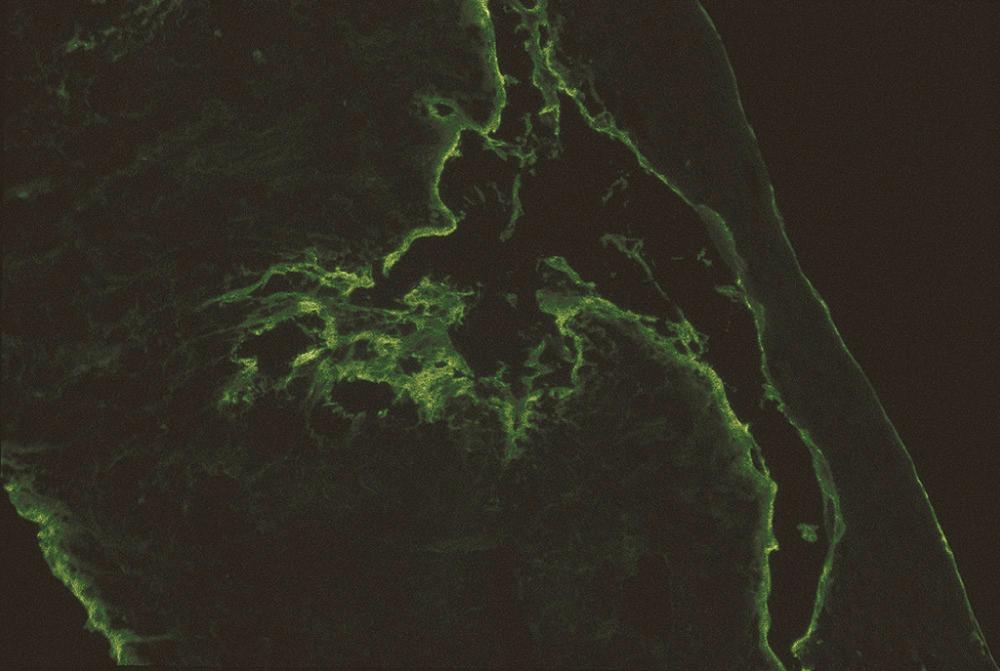
It is important to tell the patient that the goal of management is relief of symptoms, because immediate cure is not to be achieved. Those with asymptomatic reticular lichen planus do not require treatment. Topically applied agents, usually corticosteroids, are the mainstay of management in most forms of oral lichen planus that are symptomatic in nature. The use of topically administered cyclosporine as a rinse has also been helpful in cases where topical steroid use may be contraindicated. The specific form or choice of corticosteroid depends on the agent's potency, with moderate to ultrapotent agents considered the modalities of choice. More recently, the nonsteroidal topical agents tacrolimus and pimecrolimus have been shown to be effective in the management of symptomatic lichen planus without the usual adverse effects related to topical steroid use, most commonly oral candidiasis.
Management of recalcitrant focal areas of isolated lichen planus can be accomplished through the use of intralesional injections of corticosteroids such as triamcinolone suspension (10 or 40 mg/mL).
Systemic management of lichen planus can be tried in cases of severe involvement, using corticosteroids for a brief time until clinically obvious improvement is noted. Subsequently and for the longer term, topical management strategies can be used, as noted earlier. Alternatives to systemic corticosteroids include hydroxychloroquine, azathioprine, and systemic retinoids.
A considerable degree of controversy exists as to whether a small percentage of lichen planus cases are capable of transforming into oral SCC. Microscopic confusion and definitions further add to the controversy, with epithelial dysplasia having an overall lichenoid quality. There does, however, appear to be a small but bona fide risk of carcinoma evolving from proven oral lichen planus; the risk ranges from less than 1% to approximately 5% of cases, and the erosive/atrophic form of lichen planus is more likely to transform than the far more common reticular or striaform type. This emphasizes the need for long-term follow-up, given the chronic nature of the disease process and the therapies used for such.
The notion of lichenoid dysplasia versus dysplasia developing in lichen planus may not be readily settled. However, studies suggest a significant degree of allelic loss in dysplastic oral lichenoid lesions. Reports that disclose a degree of dysplasia in association with lichenoid features should alert the clinician to either remove the balance of the altered mucosa or follow the patient carefully. Mattsson and colleagues support the relationship between oral lichen planus and oral SCC, yet on an economic and practical basis, they dispute the need for continuous recall of these patients in specialists’ offices and clinics.
Finally, the issue of an “oral lichenoid lesion” versus oral lichen planus has been discussed within the context of malignant transformation. There may be an increased risk of transformation with lichenoid lesions, whereas true lichen planus may have less risk of transformation.
Submucous fibrosis represents a multifactorial disorder with the considered chief etiologic factor being the consistent and habitual use of areca (betel) nut, either chewing it, simply placing a quid of material (paan masala) in the buccal or labial sulcus several times per day, or using it in a packaged, powdered form along with other components (guthka) over many years. Submucous fibrosis is considered a premalignant condition, and transformation rates as high as 7.6% were reported from India over a 17-year period. Other researchers have reported that 2.5% of cases demonstrate epithelial dysplasia.
Some experts believe the basic process is a failure of collagen remodeling and that altered epithelial-mesenchymal interactions result in the formation of collagenous bands and aggregates within the submucosa and lamina propria. A diminished level of functional collagenase levels has been postulated as another mechanism to explain increased collagen accumulation.
Initial mucosal alterations characteristic of oral submucous fibrosis include erythema with or without vesiculation. The former reaction (erythema) is believed to be related to increased levels of inducible nitric oxide synthetase. This is followed by a slow diminishing of erythema and a progressive decrease in the degree of oral opening and tongue mobility reflective of the altered collagen metabolism. Pallor of the normally pink mucosa becomes evident as the underlying chronic inflammation recedes and fibrosis and hyalinization progress. Scar bands may become evident deep within the buccal soft tissues, which further limits jaw opening and function.
Development of SCC is characterized by a gradual thickening of the epithelial surface with hyperplastic to verrucous surface qualities becoming evident.
Dominating the histopathology is a juxtaposition of atrophic epithelium surfacing a subjacent fibrosis. Early connective tissue alterations are characterized by delicate and loosely arranged collagen fibers with progressive degrees of hyalinization until in the late stages, complete hyalinization of the supportive connective tissue is apparent. Variable degrees of chronic inflammation occur in the form of lymphocytes and plasma cells, and variable levels of dysplasia have been noted. In one study, mild dysplasia was present in 46% of cases, moderate dysplasia in 52%, and severe dysplasia in 2%.
Management of oral submucous fibrosis is problematic, particularly in advanced cases and when the use of areca-containing products continues. Surgical release procedures of scar bands have been only modestly successful. More recently collagenase and pentoxifylline administration in separate studies has been roposed.
Verruciform xanthoma represents an uncommon, benign oral mucosal lesion that also has a cutaneous counterpart where such lesions arise, particularly on the genitalia.
The cause is unknown. The cellular lineage of the proliferative xanthoma cells is of the monocyte/macrophage type. The disorder is noted chiefly in the fifth decade and has been classified into three types according to microscopic surface qualities. These include the verrucous, papillary, and flat types.
As noted, three growth types have been identified that are further characterized by being well circumscribed with minimally to obviously granular surfaces. The size of the lesions ranges widely, from 0.2 cm to 2 cm. The surface may be depressed or flat, and it may be elevated and variably granular in texture.
Variable levels of surface hyperkeratosis cover a papillary or verrucous configuration with deeply invaginated crypts that alternate with papillary extensions. Epithelial ridges composed of normal keratinocytes are elongated and extend uniformly into the lamina propria, which is engorged with numerous xanthoma cells that contain characteristic foamy to flocculent cytoplasm. Periodic acid–Schiff (PAS)-positive and diastase-resistant granules are present within the cytoplasm of these cells, as well as lipoid droplets; these cells are macrophages.
Conservative surgical excision is the treatment of choice, with no recurrence potential noted.
Candidiasis is a common opportunistic infection of the oral cavity, oropharynx, and corners of the mouth. Several clinical forms of this condition are noted, the easily recognized pseudomembranous form (thrush) in addition to erythematous, atrophic, and hyperplastic forms.
Candida albicans represents the most common candidal species, whereas C. tropicalis , C. krusei , and C. glabrata , among others, are less commonly involved. In immunosuppressed and neutropenic patients, however, these latter species are more often present. Of note is the essential shift from a commensal state to a pathologic one, in which former asymptomatic carriers of the organism now suffer from its overgrowth. Risk factors for development of candidiasis may include local and systemic factors ( Boxes 87.1 and 87.2 ). Commonly, systemic conditions such as poorly controlled diabetes mellitus and immunosuppression are associated with oropharyngeal candidiasis. Local effects or altered ecology of the region by topically delivered drugs, such as corticosteroids; xerostomia with loss or diminution of saliva's protective function; heavy smoking; and denture appliances favor development of candidal overgrowth. Crucial to the establishment of infection, which implies a shift from commensalism, is fungal adhesion to mucosal surfaces and subsequent replication. Yeast adherence to several ligands is complex. It is aided by intrinsic adhesion of the candidal organisms, which in turn bind to salivary proteins absorbed onto cell surfaces. A measure of virulence, such binding is a covalently mediated bonding that is in part related to fungal synthesis of the hyphae-associated, proline-rich surface protein.
Become a Clinical Tree membership for Full access and enjoy Unlimited articles
If you are a member. Log in here